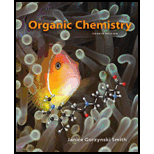
Concept explainers
(a)
Interpretation:
To arrange the bonds in the order of increasing bond length
Concept introduction:
Bond length or bond distance or inter nuclear distance. The atoms in the molecule are always vibrating with respect to each other and hence it is not possible to determine the distance between the nuclei of the atoms. This distance is called the bond length, is the average distance between the nuclei of the two bonded atoms together by the covalent bond. Bond length is related to bond order, when more electrons participate in the bond formation the bond is shorter. Bond length is also inversely to the bond strength.
(b)
Interpretation:
To arrange the bonds in the order of increasing bond length
Concept introduction:
Bond length or bond distance or inter nuclear distance. The atoms in the molecule are always vibrating with respect to each other and hence it is not possible to determine the distance between the nuclei of the atoms. This distance is called the bond length, is the average distance between the nuclei of the two bonded atoms together by the covalent bond. Bond length is related to bond order, when more electrons participate in the bond formation the bond is shorter. Bond length is also inversely to the bond strength.
Trending nowThis is a popular solution!

Chapter 1 Solutions
Organic Chemistry (Looseleaf)
- Which of the given resonance structures (A, B,or C) contributes most to the resonance hybrid? Which contributes least?arrow_forwardWhich of the given resonance structures (A, B, or C) contributes most to the resonance hybrid? Which contributes least?arrow_forwardAnswer the following questions about erlotinib and terbinafine. Erlotinib,sold under the trade name Tarceva, was introduced in 2004 for thetreatment of lung cancer. Terbinafine is an antifungal medication used totreat ringworm and fungal nail infections. Rank the labeled bonds in terbinafine in order of increasing bondstrength.arrow_forward
- a. Which of the following has a greater electronegativity? (circle one) Carbon / Cesium b. Explain why you chose your answer in Za.arrow_forwardUse the principles of resonance theory to explain why carbocation A is more stable than carbocation B.arrow_forwardDraw the molecule with bonds and and single bonds if neededarrow_forward
- identify which is the most and least basic among the given. refer to the number and stability of their resonance structure.arrow_forwardWhich of the given resonance structures (A, B, or C) contributes most tothe resonance hybrid? Which contributes least??arrow_forwardDraw a second resonance structure and the hybrid for each species, and then rank the two resonance structures and the hybrid in order of increasing stability.arrow_forward
- Chemistry: Matter and ChangeChemistryISBN:9780078746376Author:Dinah Zike, Laurel Dingrando, Nicholas Hainen, Cheryl WistromPublisher:Glencoe/McGraw-Hill School Pub Co
 World of Chemistry, 3rd editionChemistryISBN:9781133109655Author:Steven S. Zumdahl, Susan L. Zumdahl, Donald J. DeCostePublisher:Brooks / Cole / Cengage Learning
World of Chemistry, 3rd editionChemistryISBN:9781133109655Author:Steven S. Zumdahl, Susan L. Zumdahl, Donald J. DeCostePublisher:Brooks / Cole / Cengage Learning Chemistry for Engineering StudentsChemistryISBN:9781337398909Author:Lawrence S. Brown, Tom HolmePublisher:Cengage Learning
Chemistry for Engineering StudentsChemistryISBN:9781337398909Author:Lawrence S. Brown, Tom HolmePublisher:Cengage Learning  Chemistry for Today: General, Organic, and Bioche...ChemistryISBN:9781305960060Author:Spencer L. Seager, Michael R. Slabaugh, Maren S. HansenPublisher:Cengage Learning
Chemistry for Today: General, Organic, and Bioche...ChemistryISBN:9781305960060Author:Spencer L. Seager, Michael R. Slabaugh, Maren S. HansenPublisher:Cengage Learning




